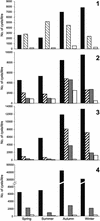Giardia cysts in wastewater treatment plants in Italy
- PMID: 12788741
- PMCID: PMC161540
- DOI: 10.1128/AEM.69.6.3393-3398.2003
Giardia cysts in wastewater treatment plants in Italy
Abstract
Reductions in annual rainfall in some regions and increased human consumption have caused a shortage of water resources at the global level. The recycling of treated wastewaters has been suggested for certain domestic, industrial, and agricultural activities. The importance of microbiological and parasitological criteria for recycled water has been repeatedly emphasized. Among water-borne pathogens, protozoa of the genera Giardia and Cryptosporidium are known to be highly resistant to water treatment procedures and to cause outbreaks through contaminated raw or treated water. We conducted an investigation in four wastewater treatment plants in Italy by sampling wastewater at each stage of the treatment process over the course of 1 year. The presence of the parasites was assessed by immunofluorescence with monoclonal antibodies. While Cryptosporidium oocysts were rarely observed, Giardia cysts were detected in all samples throughout the year, with peaks observed in autumn and winter. The overall removal efficiency of cysts in the treatment plants ranged from 87.0 to 98.4%. The removal efficiency in the number of cysts was significantly higher when the secondary treatment consisted of active oxidation with O(2) and sedimentation instead of activated sludge and sedimentation (94.5% versus 72.1 to 88.0%; P = 0.05, analysis of variance). To characterize the cysts at the molecular level, the beta-giardin gene was PCR amplified, and the products were sequenced or analyzed by restriction. Cysts were typed as assemblage A or B, both of which are human pathogens, stressing the potential risk associated with the reuse of wastewater.
Figures



References
-
- Aldom, J. E., and A. H. Chagla. 1995. Recovery of Cryptosporidium oocysts from water by a membrane filter dissolution method. Lett. Appl. Microbiol. 20:186-187. - PubMed
-
- Ballone, E., P. Fazii, G. Riario Sforza, E. Scassa, M. Di Nicola, N. Ippolito, C. Di Mascio, and F. Schioppa. 2001. Survey on giardiasis propagation in Pescara. Ann. Igiene 13:111-120. - PubMed
-
- Brandonisio, O., A. Marangi, M. A. Panaro, R. Marzio, M. I. Natalicchio, P. Zizzadoro, and U. De Santis. 1996. Prevalence of Cryptosporidium in children with enteritis in southern Italy. Eur. J. Epidemiol. 12:187-190. - PubMed
-
- Brandonisio, O., F. Portincasa, G. Torchetti, N. Lacarpia, A. Rizzi, L. Fumarola, F. Donadio, and D. Carnimeo. 2000. Giardia and Cryptosporidium in water: evaluation of two concentration methods and occurrence in wastewater. Parassitologia 42:205-209. - PubMed
Publication types
MeSH terms
Substances
LinkOut - more resources
Full Text Sources
Other Literature Sources

